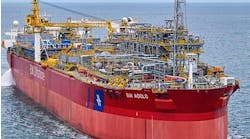Negative perceptions have impeded the take-up of titanium offshore, but the mood may be changing, according to Britain's Marine Technology Directorate.
MTD questioned 46 oil companies, mainly in the UK and Norway, over their attitudes towards current and future titanium usage. The survey identified growing potential in production and export risers and also some items of subsea production equipment.
Hitherto, titanium's apparent high cost and its piecemeal application offshore have restricted it chiefly to topsides heat exchangers. Four factors, however, have rekindled the industry's interest in the metal and its alloys, says MTD, namely:
- exploration in very deep waters
- high pressure, high temperature wells
- the fall and subsequent stabilization of prices for titanium
- long-term souring of wells.
Some large Norwegian fixed platforms now incorporate over 150 tonnes of titanium, claims MTD. The metal is strong and light - around 60% the density of steel with approximately half the elastic modulus. It is also inert to most reservoir fluids and is extremely resistant to seawater corrosion.
On the minus side, titanium has a tendency to absorb free hydrogen, resulting in brittle hydrides. It is not inert to hydrofluoric acid, which may be used for acidizing wells; and it is prone to galling, which can create problems with bolts where there is a combination of load and movement. There is also potential for damage in titanium drilling risers where the bore is exposed to wear from the drill pipe.
One positive recent development is new alloys containing ruthenium to improve resistance to crevice corrosion in hot chlorides. Ruthenium costs less than palladium which normally provides this capability in alloys. Grade 23 with ruthenium is being installed in geothermal wells to withstand the effects of hot brine: this alloy has also been evaluated by Norsk Hydro for risers on its current Visund development.
Survey findings
MTD's survey asked oil companies to identify titanium applications offshore based on the following criteria: equipment currently in use; applications under consideration; potential future applications; and applications where it is unlikely to be used. Only one outright negative response came in, from a company that believed that titanium was too exotic and expensive to be used beyond its current role in topside heat exchangers.
The questionnaire categorized applications into five areas: topsides equipment; risers and associated equipment; subsea production equipment; completion equipment; and tension leg stress joints and flowline pull-ins. Where possible, MTD targeted oil companies' central technology groups, although it accepts that in some cases, their views diverge from those of other divisions within the same company.
Most respondents said they already used titanium widely for heat exchangers, with a few in the UK also employing it for firewater and seawater systems. This is probably also the case in the US, says MTD.
Titanium drilling risers, by contrast, are still in their infancy. Respondents saw greatest potential for use in high pressure TLP drilling risers. Around half thought titanium was improbable for low pressure marine drilling risers, for instance from a semisubmersible.
Rigid production and export risers are categorized by MTD mainly as top tensional risers for use from TLPs, though they also include riser towers and production risers for use from Spar platforms. Here the respondents felt titanium would likely be confined to taper stress joints, as is currently the case on the Green Canyon and Neptune developments in the Gulf of Mexico. However, 50% of interviewees were considering titanium for catenary risers: the metal has been undergoing qualification testing for this role lately on Visund.
Turning to completion equipment, one quarter of respondents were seriously examining titanium for production tubing, but only 11% saw much of a future for the metal in coiled tubing, and casing was seen as an absolute non-starter. Titanium for very deep or deviated wells was a different proposition. Half those questioned were open-minded, with some giving serious thought to this application.
In the subsea production category, MTD concluded from the responses that titanium could be used for manifold pipes, but not on a large scale - probably on a par with the current adoption of duplex and super duplex subsea. Titanium subsea valves drew an unenthusiastic response.
The potential for flowlines is hard to assess, says MTD: views on this topic were mixed, partly due to the increasing competition from polymer-lined carbon steel pipe. Titanium is already used on umbilical and chemical injection lines, and the trend here looks to be upward. Almost 90% of respondents saw possibilities for titanium in flowline jumpers, with 12% actively considering it in this regard. Costain Subsea has already tested it for deepwater diverless pull-ins.
Titanium was on no one's agenda for flowline ends for `J' tube pull-ins, although half did not rule out future application. Amongst miscellaneous ideas proposed for the metal, one company suggested it would be useful as a flow tube material for multiphase flowmeters where an ultra-thin wall would be required. Some companies reported using titanium springs in check valves, with one suggesting that flowline pull-in porch locks and stab protectors could be designed better using titanium as a spring element.
MTD incorporated the results of its survey into a report which also lists current R & D projects as well as identifying areas where further research might be needed. These include welding of titanium and design guidance for use in catenary risers.
Copyright 1996 Offshore. All Rights Reserved.


